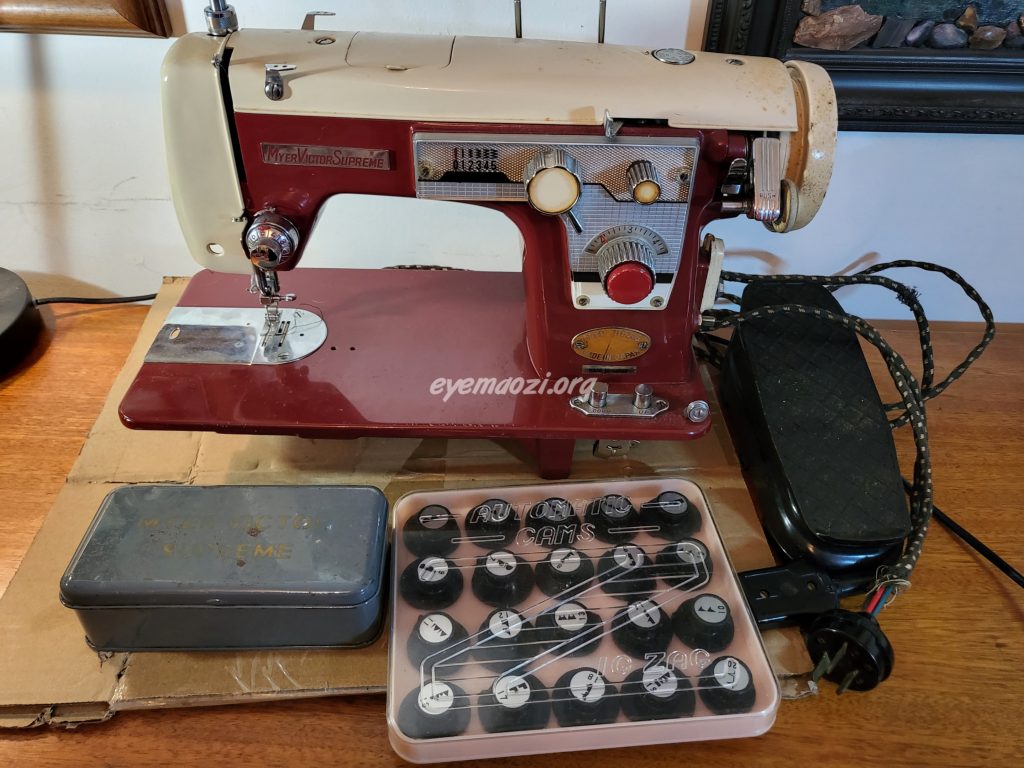Post second World War the Japanese manufactured sewing machines. Many of these came to Australia. They were rebranded by department stores and the like. They are known by many names, including Pinnock, Lemair, Myer, Victor, H G Palmer, too many to mention.
Most Japanese machines arriving in Australia were fitted with a quality Wernard motor and a black Bakelite foot pedal. They came with an accessories box with extra bobbins, attachments and even a screwdriver. Placed in a pine case with a lid, with a top handle, the case lids came in many colours. These plastic handles were not designed to carry 20kg of metal machine and as such many handles are broken or torn off. DO NOT carry these by the case handle, carry from underneath the base.
The one outstanding feature of the Japanese machines is their quality and their beauty. All metal machines (later ones came vinyl gears) in an array of colours with shiny chrome features. It was on one of these machines that I learnt to sew back in the 1970s, a straight stich, solid heavy machine that still sits in the bottom of my mother’s wardrobe. I am sure there are many more sitting in wardrobes in the houses of Australia, just waiting to be discovered again. Plenty show up on the social media sales and auction sites. Now in 2022 they can range in price from $20 to $200. You will find the $200 ones still listed for sale months for now, the demand is just not there, so they are not an expensive investment, but they are surely value for money.
If you come across a Japanese all metal machine and it appeals to you, do not hesitate to acquire it. Parts are easy to find. Standard type 15 bobbins and needles that you can get anywhere. Easily threaded and operated, you don’t normally need a manual as these are all basically the same. Straight stitch and sometimes with zig-zag. If you are lucky enough to find one that takes cams (pattern stitch disks) make sure you ask the seller if they have these, as these often go missing. The machine will still operate as a zig-zag but you won’t be able to do the fancy stitches, which by today’s standards are not that fancy, but just a bit of fun. Oiled and well maintained, these machines will last a lifetime and look awesome in the process.
To see more of my Pinnock collection you can start here.
The Lemair Valiant 930 machine in my collection can be seen here.
Below are images of some of the other machines in my collection. Images from when the machines arrived and still on my workbench or in my boot.












I have recently bout one of these machines. My friend took apart the tension disk without taking photos and we can’t work out what order the parts go back in. It is I think the same as the first photo up here. It would be so greatly appreciated if you could send me a photo of the parts and what order they go in. Happy to email photos of ours for you too look at also
Jade, most of the Japanese machines will have the same tension assembly. If you join one of the Japanese machine groups you should be able to find a detailed diagram of how the tension knobs go back together. I have seen photos, but I cannot recall where.
My grandmother’s sewing machine looks like one of these – it’s a vogue stitch. It will only sew zigzag – anyone know how to make it do a straight stitch?
I suggest you join the Facebook group https://www.facebook.com/groups/659877447448317 there you will probably find a manual for free to explain your particular machine.
Hi,
Can you still get black and white fabric covered power cord in Australia?
Thanks for your help.
Tom
I have only ever purchased the black fabric covered cord a few years back, I could not find the one with white flecks marks at that time. I found mine by searching “vintage radio power cord” so I would suggest trying Vintage radio parts as this may lead you in the right direction.
Hi
I have a
CFM SUPER PRODUCTS MAPLES BLUEBIRD MODEL RQZAS-5
The machine is in great condition except it has a broken cogthat drives the bobbin. I think it’s a nylon cog.
Can you tell me if it is possible to purchase these parts anywhere please.
Kind regards
Vicki
Hi Vicki, Your machine will be a Japanese machine, as you already know. Unfortunately, many different machines where rebranded Maple, so without a photo it is hard to tell which machine is yours. One of my first Pinnocks was a CFM and it turned out that it was released worldwide as a Dressmaker 2000, once I discovered this, I was able to find the manual and find out which plastic gear was the issue.
I have no sources for finding nylon gears, except a sewing machine tech or online such as ebay. I would suggest you join the Vintage Japanese Sewing machine group on facebook. https://www.facebook.com/groups/659877447448317 There you can search for your machine or just post a photo and someone can identify it. Once you have done this you can search for your part online.
I eventually was able to find that my machines gear was reproduced in steel and I could order it from o/s, but the postage alone was not worth it to me, let alone the time it would take for me to then replace it in the machine. My Pinnock Dressmaker 2000 can still do straight stich, but not zig zag, I’m happy with that. A photo of my Dressmaker is on the bottom of my “about me” page. https://eyemaozi.org/en/artist-contact/
Good luck, cheers Patricia